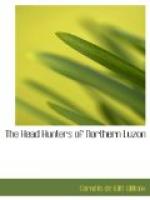The day was fine, the trail good—like all the others of Gallman’s trails,—and the people glad to see us. From time to time, as we neared Sabig, we were met by detachments, each with gansas and spears and our flag, and, besides, bubud in bamboo tubes; for, as must now be clear, the Ifugaos are a hospitable and courteous people, and we were made welcome wherever we went.
At about three we reached Sabig, situated on a hog-back between the trail on the left and a deep valley on the right. Here the people had built us the finest rest-house seen on the trip. For this house had separate rooms all opening on the same front, the roof being continued over the front so as to form a sort of veranda, under which a bamboo table had been set up. But, as though this were not enough, there were hanging-baskets of plants, bamboo and other leaves ornamenting the posts. Our cattle were as well off as we, having a real stable with separate stalls. Just north of the house, where the ground sloped, a platform had been excavated for dancing, which went on all night. There was the customary distribution of slips and the usual business of reports and interviews with the head men. Here we first saw the rice-terraces for which these mountain people are justly famous, that is, terraces climbing the mountain-side. But of weapons we saw none.
CHAPTER XVI
Change in aspect of country.—Mount Amuyao and the native legend of the flood.—Rice-terraces.—Banawe.—Mr. Worcester’s first visit to this region.—Sports.—Absence of weapons.—Native arts and crafts.
We pushed on next morning early for Banawe, the capital of the sub-province of Ifugao, and Gallman’s headquarters. The cheers of our late hosts accompanied us as we entered the trail and began to climb. The country now took on a different aspect, due to our increasing altitude. The valleys were sharper and narrower, and so of the peaks. From time to time we could see the proud crest of Amuyao ahead of us. Over 8,000 feet high, this mountain, whose name means “father of all peaks,” or “father of mountains,” is the Ararat of the Ifugaos. Their legend has it that, a flood overcoming the land, a father and five sons took refuge on this topmost peak, coming down with the waters as they fell. They even have their Cain, for one of these five was killed by a brother. This family traditionally are the ancestors of all the mountain people.
It took us some five hours to ride to Banawe, through a country of imposing beauty. It was not that we were in the presence of mighty ranges or peaks, so much as that the alternation of elevation with depression offered a bewildering variety of aspect. At every turn, turns as unnumbered this day as the woes of Greece, the landscape changed its face. No sooner had one’s appreciation become oriented, than it had to give way to the necessity of a fresh




